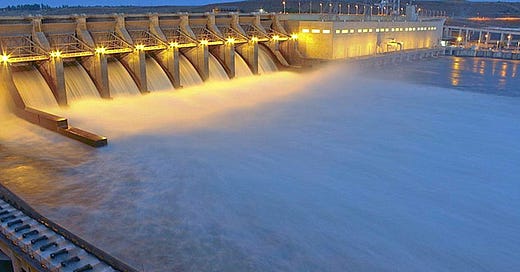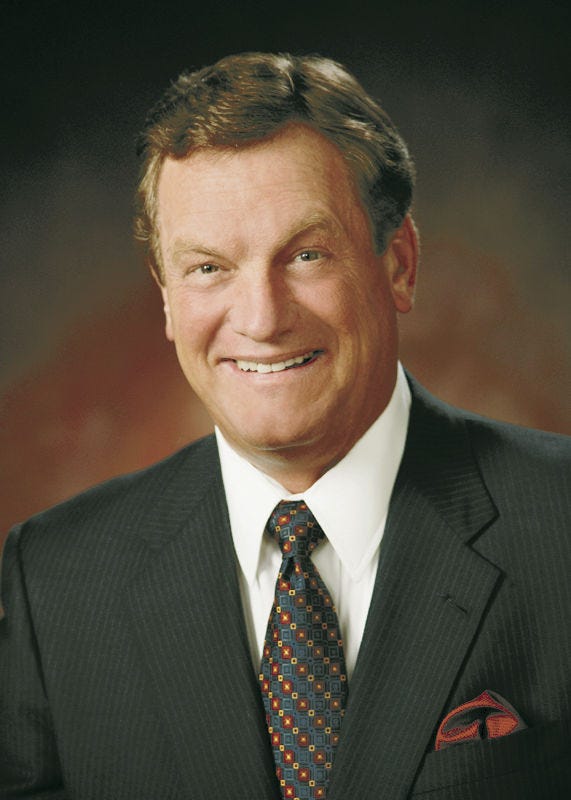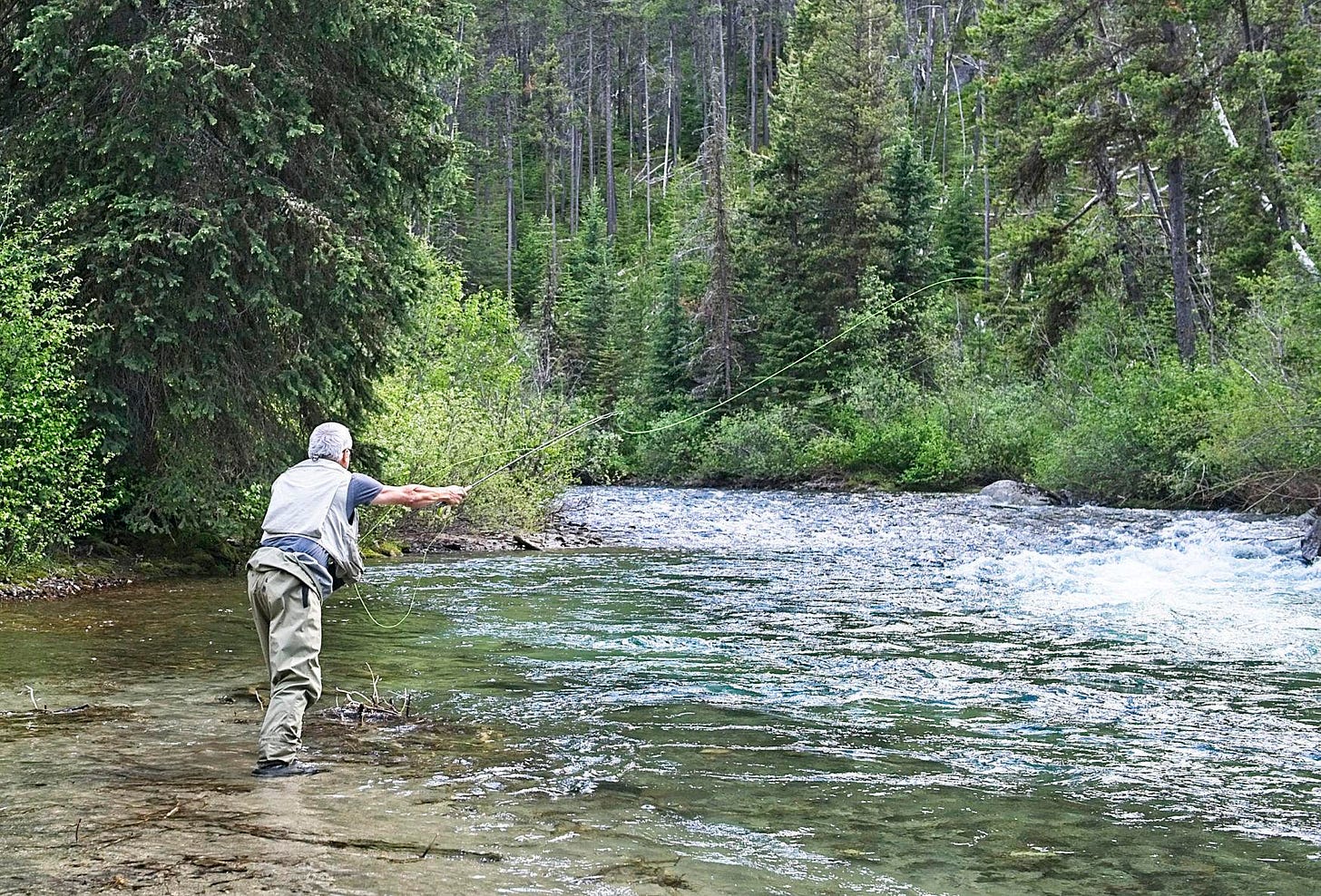A plan to say 'yes' to Snake River Salmon
Can salmon and their ecosystems, diverse human communities, and the built environment not only coexist but adapt and thrive into the (climate-impacted) future?
Christina deVillier is a writer, a gardener, and a fourth-generation explorer of northeast Oregon's mountains, canyons, and communities.
On May 13, the Andrus Center for Public Policy at Boise State University convened an all-star symposium to discuss the future of the Columbia River Basin. The central question: Can salmon and their ecosystems, diverse human communities, and the built environment not only coexist but adapt and thrive into the (climate-impacted) future?
This question has been contentious for decades, and folks have a tendency to retreat into their corners when it comes up. But over the past few months and years, some elected leaders in the Pacific Northwest have begun to say: if we can’t come together — soon — to answer this question with a bold and detailed and proactive YES, what the heck are we doing in government?
In February, a Republican from Idaho, Rep. Mike Simpson, released a comprehensive framework that tries to problem-solve its way to YES. This framework is not a bill, but rather a starting point for federal legislation — an invitation to other Northwest leaders to work together to secure a fighting chance for iconic Snake River salmon runs while investing in Columbia Basin stakeholders, communities, and ecologies. As of early May, Rep. Earl Blumenaur of Oregon has stepped up to join Simpson in this big work.
This means that one of the most conservative members of Congress and one of its most progressive have committed to bipartisan problem-solving at the federal level to ensure a robust future for the Northwest's agriculture, energy grid, communities, and keystone species. Oregon’s Gov. Kate Brown and 12 Columbia Basin Tribes are also pushing for bold solutions, and fast. Bipartisan, collaborative, cross-cultural leadership like this is urgently needed — not only for salmon in crisis, but for all the intersecting problems (and opportunities) of this moment.
Salmon are struggling all over the world and acutely in the inland Northwest. Scientists warn that Snake River Runs, in particular, are rapidly approaching extinction. The demographics and economics of the Pacific Northwest are shifting, too. The energy landscape is changing rapidly and dramatically. And climate change, including this spring’s drought, is putting yet more pressure on Oregon’s salmon and our agricultural producers.
In the face of these interlocking challenges and changes, the Pacific Northwest congressional delegation is more powerful than it has ever been. And a federal infrastructure bill is coming down the pipeline that could potentially pull in serious money for addressing all of the pieces of this puzzle.
Simpson wants to earmark $33 billion federal infrastructure dollars for a “Columbia Basin Fund,” and work out the details of how that money would be spent in collaboration with his colleagues, on a defined timeline that reflects the urgency of the salmon and climate crises. His framework, the result of hundreds of meetings and years of work, is a strong if imperfect starting point for negotiation.
Some Pacific Northwest leaders seem to think the timeline is too tight to act this year. On May 14, Washington Gov. Jay Inslee and Sen. Patty Murray released a statement that pivots away from Simpson's framework while suggesting a path forward that sounds ... well, a lot like Simpson's framework.
The two WA leaders emphasized urgency, salmon recovery, stability for agricultural and other interests, a bold energy future for the northwest, and upholding Tribal fishing rights. Their statement is short on details for how these aspirations will be achieved and funded, however.
The Inslee-Murray statement was immediately slammed by Tribal leaders and others. “This is a moment for action, not for more process,” said Nez Perce Tribal Chairman Samuel L. Penney. “Gov. Inslee and Senators Murray and Cantwell have stated what they’re against, providing no substance with respect to what they’re for.”
That’s the crux of this issue, I think. What are we for? What are we going to say YES to? Change is hard, but it’s coming whether we like it or not. Wouldn’t we prefer to be proactive—to define our own future, together, as Oregonians and Northwesterners?
I think that Gov. Inslee and Sen. Murray have added momentum to the regional conversation by acknowledging the extinction tragedy that is unfolding in the Snake River Basin on their watch. They’ve committed to an accelerated process for solving this snarl of interrelated problems. But we need more than process from our leaders. We need vision.
We’re beginning to see it, in fits and starts, first in one quarter and then in another. Can we come together as a region, with urgency, to problem-solve for the Columbia River Basin in a comprehensive way that makes everyone whole?
YES, I think so, if we bring folks together, think big, listen carefully, and commit.
My question for all of us at The Oregon Way is: What might Oregon’s YES look like, at the center of the Venn diagram of energy, climate and water, agriculture, endangered fish, infrastructure, and community?
In the course of my work on this issue, I’ve had many conversations with my neighbors in rural Northeast Oregon about the concrete opportunities we see in Simpson’s framework — opportunities that overlap with our real needs and interests.
These are the “YESes” that make sense for my community, in my beautiful corner of Oregon with its 1,000-plus miles of Snake River tributaries. Take a look and see if any of these ideas get your wheels turning. What opportunities exist for your own community in the big work ahead?
In Northeast Oregon, Simpson’s Columbia Basin Fund framework suggests opportunities spanning several categories:
Energy Production: Simpson’s package suggests investments in new power generation to replace the 2-4% of the region’s power currently produced by the lower Snake River dams, which must be breached to give Snake River salmon a shot at a future. Some of that generating capacity should be distributed energy resources (DER) — household- and community-scale energy and demand management infrastructures — and some of those DER projects should be developed in rural Eastern Oregon, producing and keeping jobs and innovation here, and contributing to energy self-sufficiency.
Energy Efficiency: Energy efficiency is the other side of the “power replacement” coin. We should work with the Oregon delegation and Gov. Brown to make sure that energy efficiency incentives are embedded in eventual infrastructure legislation and are available to rural Oregonians, especially in the agricultural sector where increasing costs of irrigation are a growing concern.
Substation Improvements for Grid Resilience: Right now, even though we produce some energy locally, our substations are not equipped to distribute that power without access to the larger regional grid. This means our grid is vulnerable to disasters such as wildfires. Updating rural substations for the 21st century could allow for nested “microgrids” that could continue supplying power to our most essential services using local generation resources even if a disaster disrupted our connections with the larger grid. We should understand Simpson’s proposal as an opportunity to envision the grid we are going to need 50 years from now.
Irrigation Modernization: More money in existing programs for irrigation modernization would save money and energy for irrigators and also keep more (and colder) water in-stream for fish. Simpson’s proposal only covers irrigation improvements directly related to the lower Snake River corridor, but irrigation should be modernized throughout the basin, including in Northeast Oregon’s headwaters communities.
Place-based planning: Communities in Eastern Oregon are already working together to define the future of natural resources stewardship in our communities. Continued funding for climate-smart land use planning, monitoring, and adaptive management, especially of water and riparian systems, should be embedded in the eventual package.
Conservation Stewardship Program and Conservation Reserve Program (NRCS): Existing programs that incentivize landowners to protect riparian systems throughout the Columbia River Basin should be expanded and improved to be more robust, simple to implement, and a true contributor to the bottom line for land stewards. As salmon respond to a friendlier Snake River ecosystem, their spawning grounds in headwaters communities like ours must stay friendly, too.
In-Stream Flow Augmentation: We should increase the amount of money in the funding pools that compensate irrigators for putting water back in-stream for late-season fish. Most in-stream flow agreements are currently brokered with BPA money; Simpson’s infrastructure proposal caps BPA’s contributions to fish and wildlife funding in the basin at $600 million per year and shifts the management of that funding to Pacific NW Tribes and states. We need to keep track of that money, and deepen the pool for in-stream flow augmentation if possible.
Habitat Restoration and Fisheries Programs: Most habitat restoration work in Northeast Oregon is funded by Bonneville Power Administration in mitigation for the effects of the dams. If fish and wildlife funding is shifting in the basin, we need representation to ensure our Northeast Oregon fish and wildlife projects (and dozens of career jobs) don’t get lost in the shuffle.
Wallowa Lake Dam: The redesign of the Wallowa Lake Dam represents years of work and many compromises and commitments by many local and regional stakeholders. While Covid-19 threw a wrench into the implementation of this project, we should absolutely advocate for our dam’s renovation (complete with volitional fish passage) to be included in Snake River basin infrastructure legislation.
Sockeye Reintroduction: The Nez Perce Tribe and others are planning to reintroduce sockeye to Wallowa Lake, which would be monumental (and an enormous gesture of faith in our Northeast Oregon climate-resilient cold water refugia). However, other sockeye runs have already been negatively impacted by warm reservoir waters in the Snake and Columbia, including in 2015 when almost the entire Snake River run died in fatally hot water. Restoration of the lower Snake will likely result in healthier temperatures throughout the mainstem Snake and Columbia Rivers, which may be definitive for our local sockeye program’s success.
Move Roads Out of Floodplains and Improve Fish and Wildlife Passage: An infrastructure bill is a perfect opportunity to create jobs restoring floodplains and waterways. One way to do this is by supersizing culverts and moving outdated infrastructure, including some roads, to more ecologically sensible locations, improving wildlife passage and enhancing the productivity of riparian areas.
Improve Angling and Ecosystems for Locals and Tourists: While out-of-area salmon and steelhead anglers bring tens of millions of dollars into Northeast Oregon annually, local outfitters have had to adjust their businesses in recent years to accommodate fishing closures and fisheries declines. Extensive research shows that restoration of the lower Snake is the single best thing we can do to help Snake River runs rebound. It’s hard to believe that there were once enough salmon returning to Wallowa County headwaters to feed Nez Perce people at a rate of 300 pounds per person per year, or to support two sockeye canneries at Wallowa Lake, but these things are true. While that kind of abundance will not return overnight no matter what we do, a comprehensive solution on the lower Snake represents our community’s best shot at a future with salmon.
Northeast Oregonians have been innovating and collaborating on behalf of our waterways and fisheries for decades. In Wallowa County, we are proud of having created a first-of-its-kind land management framework centering salmon, back in 1992. Across Northeast Oregon, irrigation districts and landowners, the Nez Perce Tribe and the Confederated Tribes of the Umatilla Indian Reservation, rural counties, conservation and agency professionals, and fisheries experts have worked together to craft stewardship solutions that solve problems for all, improve local ecosystems, and create careers and recreation opportunities.
We’re rightly proud of that strong history of collaboration and learning (and relearning) how to do right by our waterways. We are talking about hundreds of millions of private and taxpayer dollars and sweat equity and countless hours around tables and countless compromises poured into our waterways over decades.
And yet we haven’t seen much ROI when it comes to salmon and steelhead returns. Every Snake River run is still endangered. Something drastic needs to change, and Simpson’s proposal is the first attempt we’ve seen to shepherd that change holistically. It’s time for our regional leaders to step up and collaborate for fish and rivers as we’ve been doing in our neck of the woods for decades.
The Nez Perce Tribe, the Wallowa Lake Irrigation District, ODFW and many Northeast Oregon residents and landowners are already working together with a more abundant future in mind. The reintroduction of sockeye to Wallowa Lake and the return of Coho to the Lostine River are only the latest in a series of salmon restoration efforts — acts of faith, science, and innovation — that we are proud of. The long-term success of these efforts depends on conditions elsewhere in the basin, including on the lower Snake.
Our communities are already thinking years ahead, already solving problems, already saying yes to a more abundant future. We need Oregon’s leaders to step up with us, for us, for all of us, proactively, and soon.






